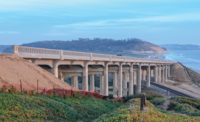Prior to the construction start, crews from Caltrans and the Bay Area Toll Authority (BATA), which is funding the project, placed netting and installed other exclusions on parts of the south end of the bridge. They also placed nesting boxes near the bridge as an alternative.
Once the work began in earnest, the required Bird Protection Plan (BPP) was completed and Caltrans brought aboard its biologist to work with Sandkohl in finding ways to keep the birds away. CEC installed more than 16,000 linear ft of corner guards on the pier columns to keep the swallows from building their mud nests. The firm also installed bird spikes and steel mesh to cover cracks, pockets, crevasses, holes and ledges. Add to that, Banke says a full-time crew was formed to monitor nesting prevention.
The team also installed a high-pressure water line from one end of the bridge to the other with a valve placed at each pier. Crews would attach a water hose and wash away nests in early formation.
Though not every method worked as planned, the Caltrans and CEC biologists say that because of the 20 owl boxes placed near the bridge, there were more owl chicks hatched and fledged in the 2011 nesting season during construction than were hatched in 2010 prior to construction.
The bearings and bracing elements of the retrofit, according to a joint Caltrans/CEC report, went a bit smoother thanks to some contract change orders and some sequencing recalibrations.
“Our main strategy was to retrofit the bridge without retrofitting the foundations,” says Coe.
For the bearings replacement, Banke says a major challenge involved jacking the bridge at each of the piers so that the existing bearings could be removed and replaced with new friction pendulum type bearings.
But the bearing supplier required that the friction bearings remain locked until all bearings in a frame had been replaced; there are five frames, or spans, on the bridge. In addition, to stop the bridge frame from creeping, the friction pendulum bearing designer requested fabrication of restraining brackets to be strategically installed at six locations.
These requirements threw CEC’s schedule out the door. Caltrans worked out a solution to minimize schedule impacts by eliminating the requirement that installation of the pier bracings be completed before the bearing replacement in the project schedule.
Coe says Caltrans engineers indentified a problem prior to the project going out to bid with the tubular welding specifications and code compliance for the pier bracing element. The welding code became more stringent prior to preliminary planning, so Caltrans and CEC worked with the fabricator – Brooklyn Iron Works, Spokane – to come up with a way to use current welders who had not yet been retrained in new weld procedures. A large “windmill” device was devised that would allow the bracings to rotate so that the tubular welds could be performed in the flat or horizontal positions and be achieved with current welding crews while keeping the desired high quality of welds.












Post a comment to this article
Report Abusive Comment